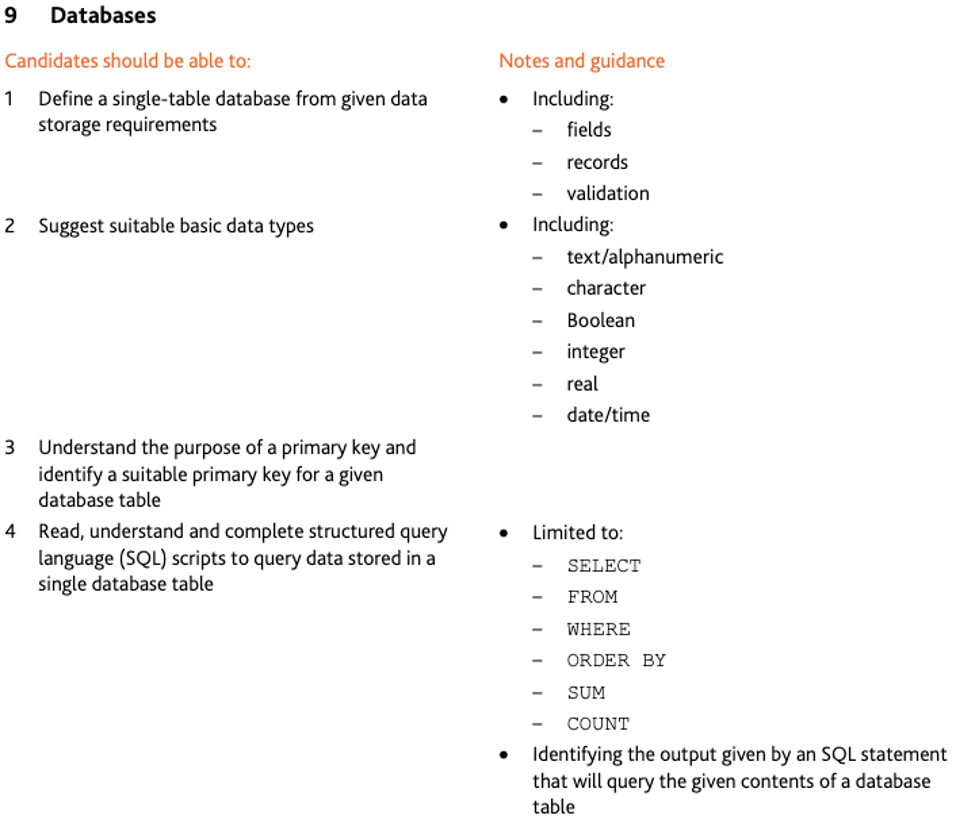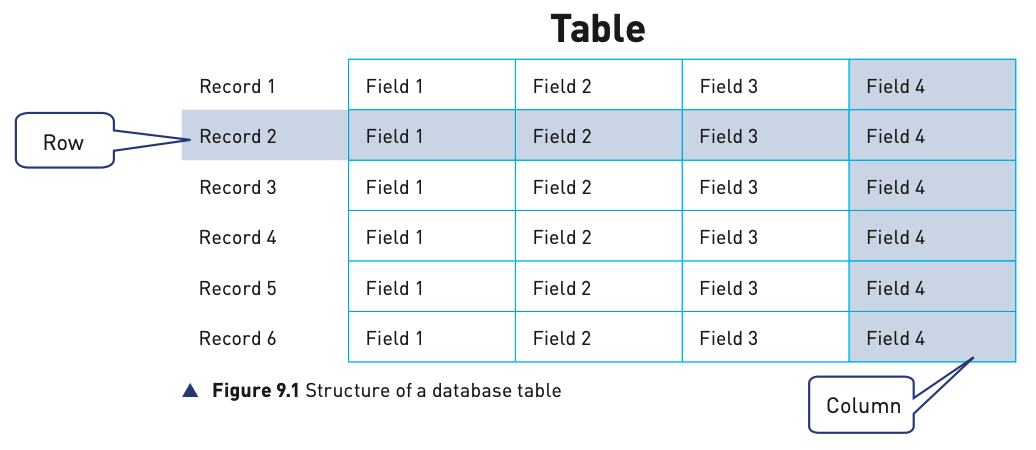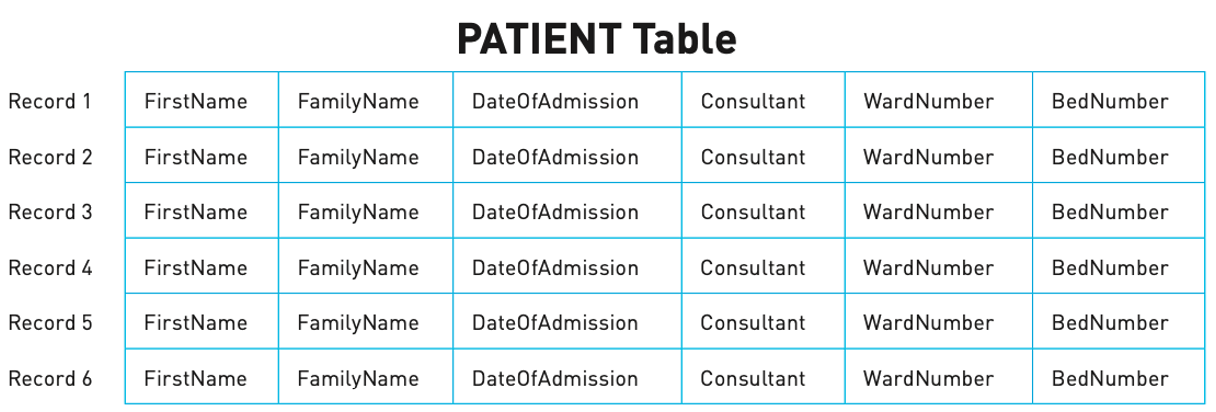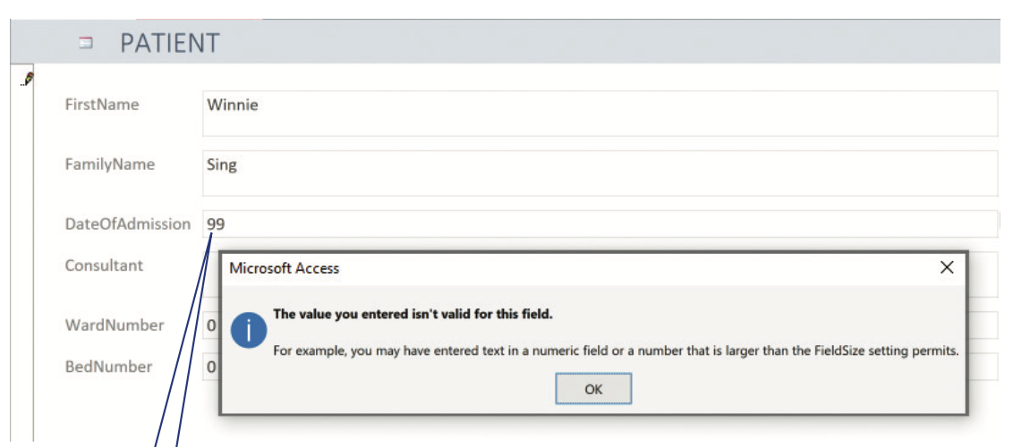Database

Single-table database
A database is a structured collection of data that allows people to extract information in a way that meets their needs.
The data can include text, numbers, pictures; anything that can be stored in a computer.
Relational databases will be studied at A Level but for IGCSE only single-table databases will be studied.
A single-table database contains only one table.
Why are databases useful?
- Databases prevent problems occurring because:
- if any changes or additions are made it only has to be done once – data is consistent
- the same data is used by everyone
- data is only stored once in relational databases which means no data duplication.
What are databases used for?
To store information about people, for instance:
- patients in a hospital
- pupils at a school.
To store information about things, for instance:
- cars to be sold
- books in a library.
To store information about events, for instance:
- hotel bookings
- results of races.
Fields and records
TIP
- each record is a row in the table
- each field is a column in the table.
- Inside a database, data is stored in tables, which consists of many records.
- Each record consists of several fields.
- The number of records in a table will vary as new records can be added and deleted from a table as required.
- The number of fields in a table is fixed so each record contains the same number of fields.

A table contains data about one type of item or person or event, and will be given a meaningful name, for example:
- a table of patients called PATIENT
- a table of books called BOOK
- a table of doctor’s appointments called APPOINTMENT.
Each record within a table contains data about a single item, person or event, for example:
- Winnie Sing (a hospital patient)
- IGCSE Computer Science (a book)
- 15:45 on January 2020 (an appointment).
As every record contains the same number of fields, each field in a record contains a specific piece of information about the single item, person or event stored in that record.
Each field will have a meaningful name to identify the data stored in it, for example:
For a hospital patient the fields could include:

Validation
The role of validation was discussed in Section 7.5.
It may be worth the reader revisiting this part of the book before continuing with this chapter.
For example, the
DateOfAdmissionfield will automatically be checked by the software to make sure that any data input is a valid date before it can be stored in thePATIENTtable.

Basic data types
- Each field will require a data type to be selected. A data type classifies how the data is stored, displayed and the operations that can be performed on the stored value.
- There are six basic data types that you need to be able to use in a database:
| Data Type | Description | Example |
|---|---|---|
| text/alphanumeric | A number of characters | apple |
| character | A single character | a |
| Boolean | either True or False | True |
| integer | Whole number | 10 |
| real | A decimal number | 18.0 |
| date/time | Date and/or time | 11/11/2022 |
Primary keys
- As each record within a table contains data about a single item, person, or event, it is important to be able to uniquely identify this item.
- In order to reliably identify an item from the data stored about it in a record there needs to be a field that uniquely identifies the item. This field is called the primary key.
- A field that is a primary key must contain data values that are never repeated in the table.
- For example: ID is the primary key in
Studenttable.
Student
| ID | FirstName | LastName | Age | ClassID |
|---|---|---|---|---|
| 1 | Jack | Smith | 10 | 1 |
| 2 | Tom | Bush | 11 | 2 |
| 3 | Tina | White | 11 | 2 |
Structured Query Language (SQL)
- Structured Query Language (SQL) is the standard query language for writing scripts to obtain useful information from a database.
- We will be using SQL to obtain information from single-table databases.
- This will provide a basic understanding of how to obtain and display only the information required from a database.
- Only the SELECT and FROM commands are mandatory in an SQL script. All other commands are optional.
SQL scripts
- An SQL script is a list of SQL commands that perform a given task, often stored in a file so the script can be reused.
Online SQL
https://sql.js.org/examples/GUI/
SQL operators
| Operator | Description |
|---|---|
| = | equal to |
| > | greater than |
| < | less than |
| >= | greater than or equal to |
| <= | less than equal to |
| <> | not equal to |
| BETWEEN | between a range of two values |
| LIKE | search for a pattern |
| IN | specify multiple values |
| AND | specify multiple conditions that must all be true |
| OR | specify multiple conditions where one or more conditions must be true |
| NOT | specify a condition that must be false |
SQL Command
| SQL(DML) query command | Description |
|---|---|
| SELECT FROM | Fetches data from a database. Queries always beginwith SELECT. |
| WHERE | Includes only rows in a query that match a given condition |
| ORDER BY | Sorts the results from a query by a given column eitheralphabetically or numerically |
| SUM | Returns the sum of all the values in the column |
| COUNT | Counts the number of rows where the column is not NUL |
SELECT FROM
SELECT LastName, Age FROM Student;WHERE
SELECT LastName, Age FROM Student
WHERE Age > 10;ORDER BY
SELECT LastName, Age FROM Student
WHERE Age > 10
ORDER BY Age;SUM
SELECT SUM(Age)
FROM StudentCOUNT
SELECT COUNT(*)
FROM Student